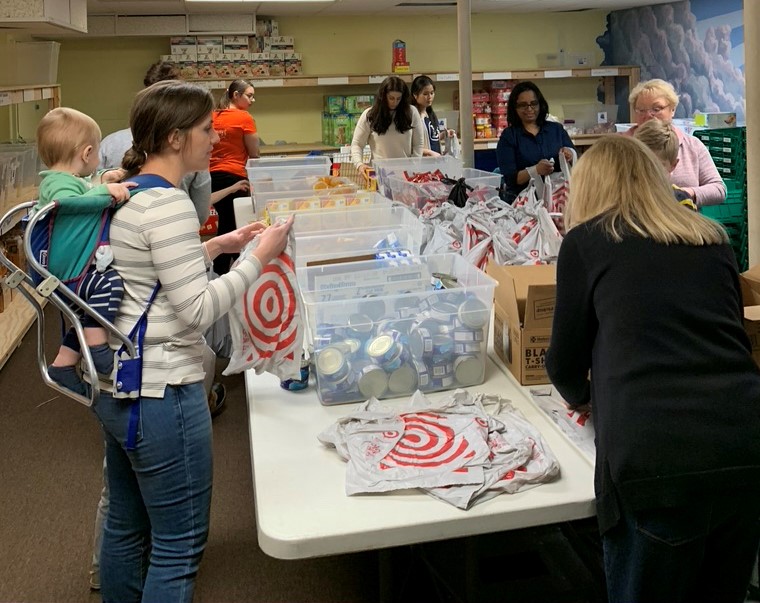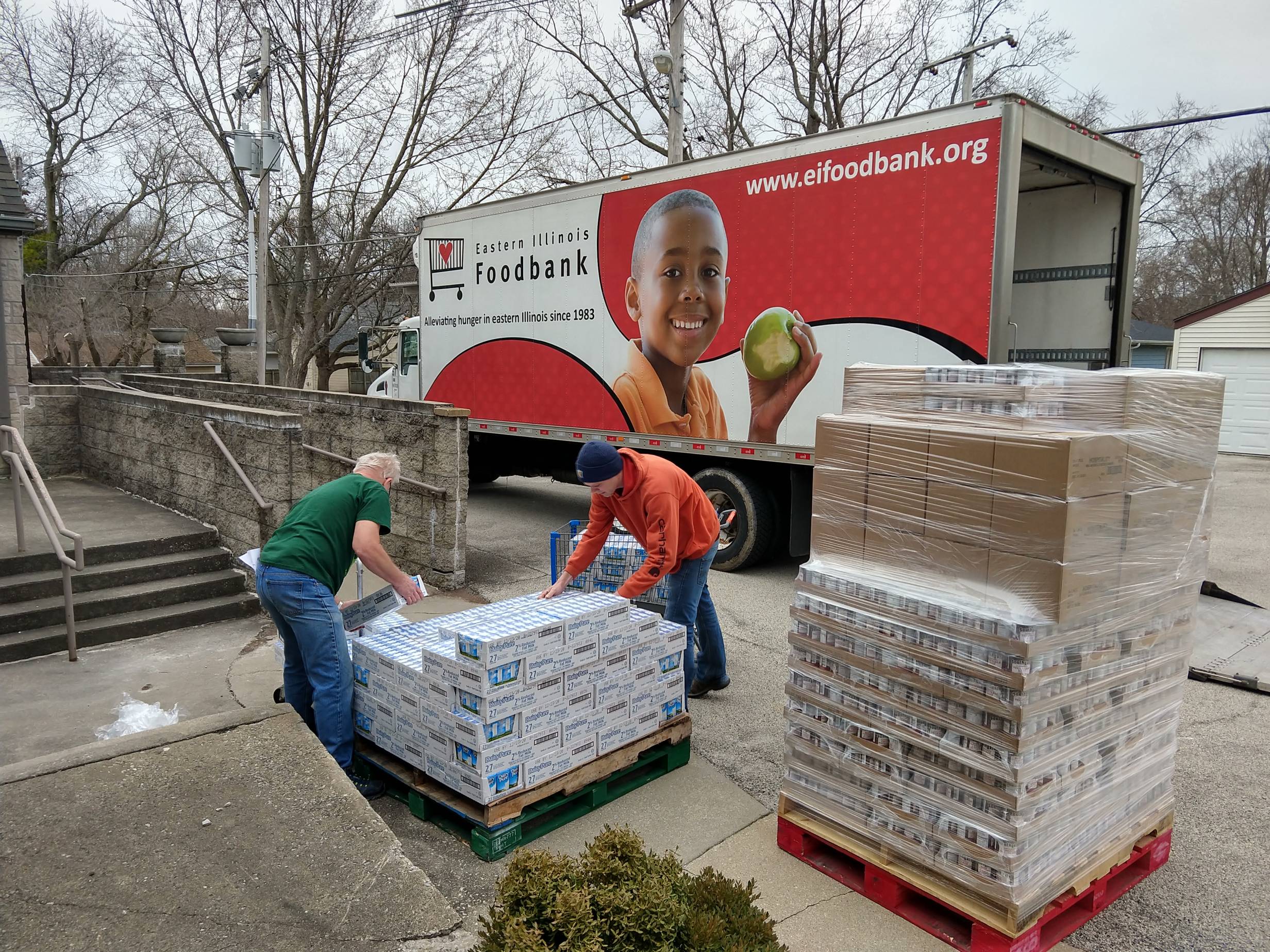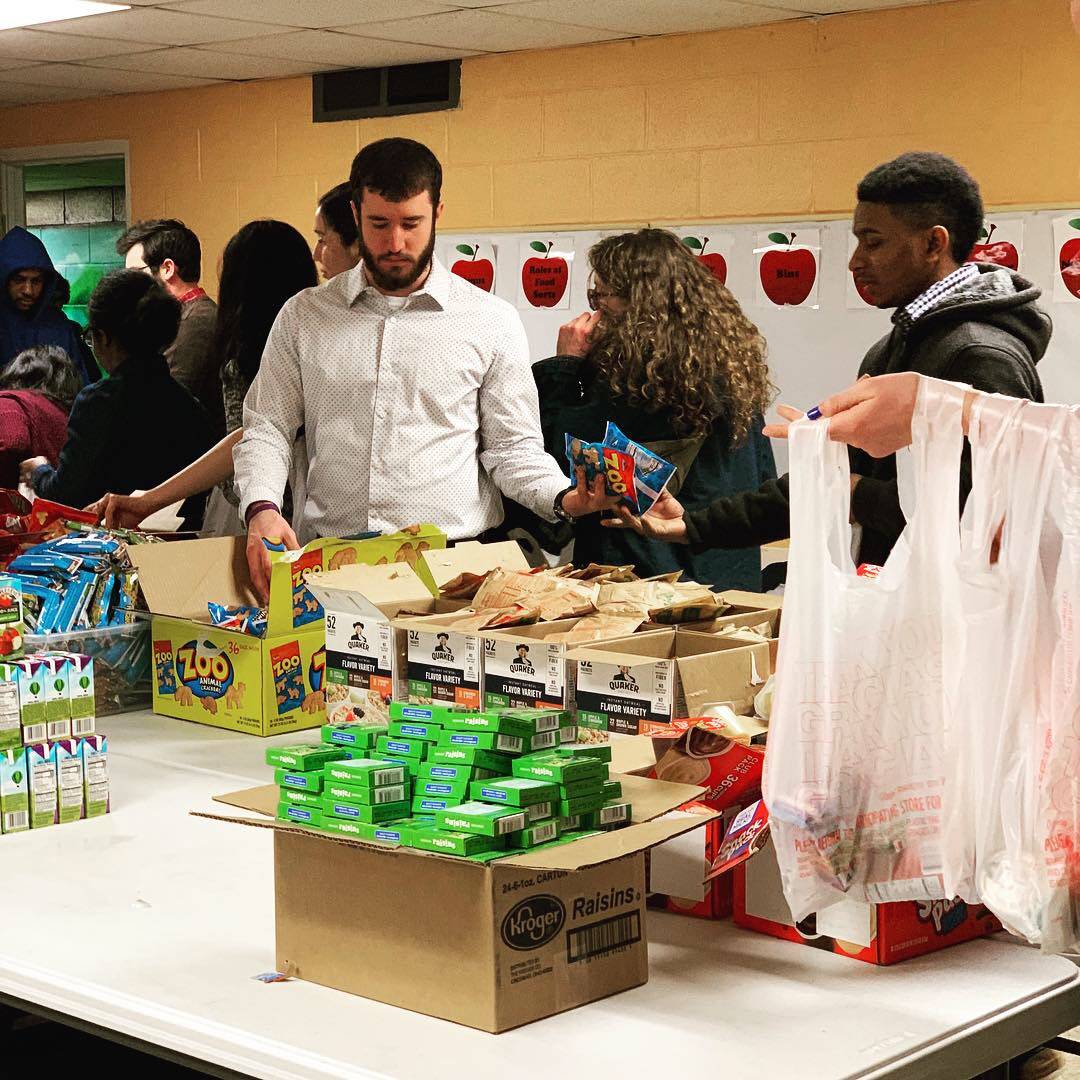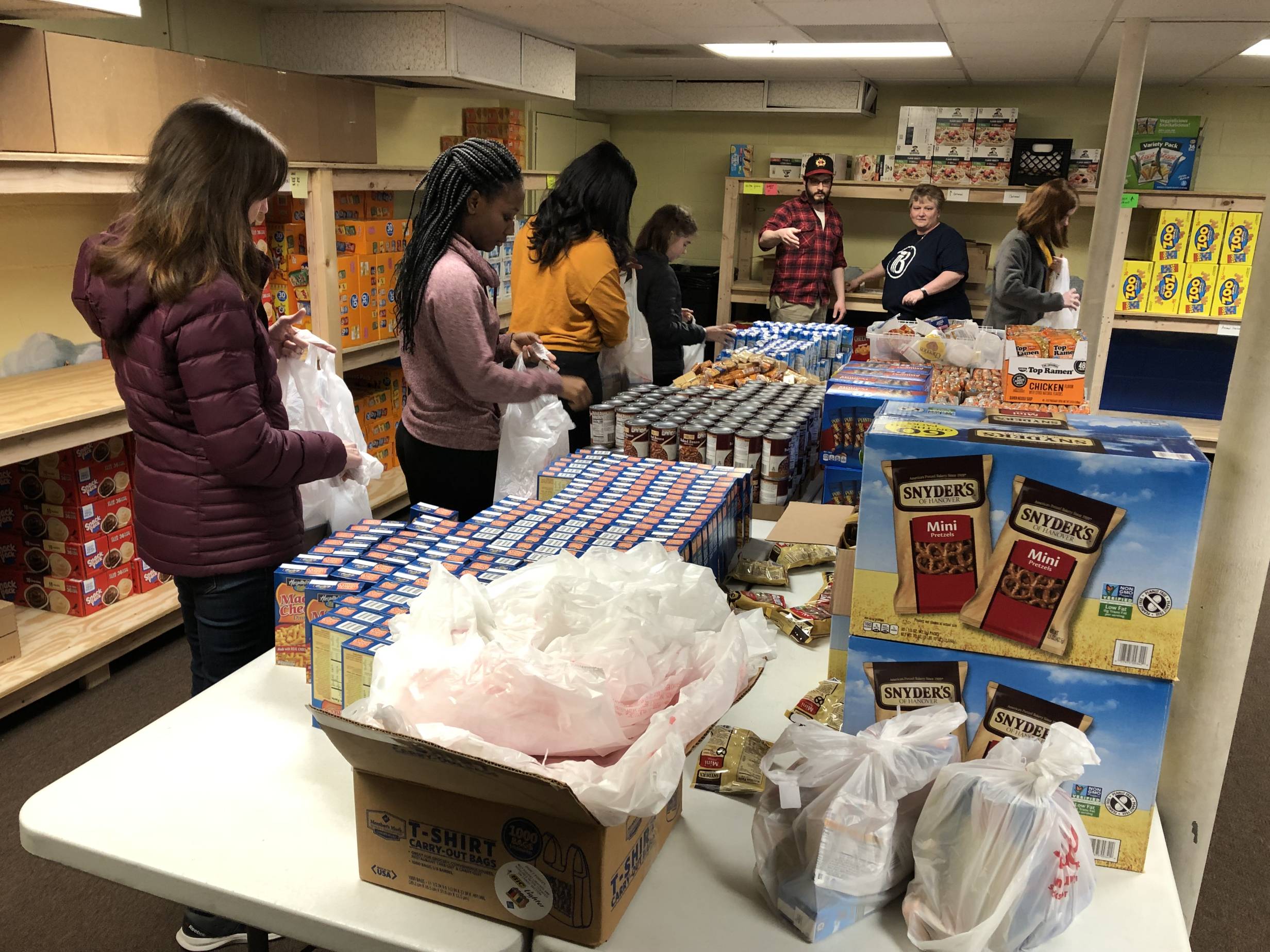Having an afternoon snack or dinner is not a given for all the students in C-U. A heartbreaking number of children in our community are currently facing food insecurity. Thankfully, the Feeding Our Kids nonprofit works with local partners, donations from C-U residents, and volunteers to provide shelf-stable food items to more than a thousand local children. Founded by two moms who wanted to help their children’s peers who were hungry on field trips and saving school snacks to take home for dinner, Feeding Our Kids continues to provide food to students who need it the most.
I talked with board member Andrea Sullivan and executive director Matt Hausman about the history of the nonprofit, why they became involved, and how C-U can provide support to this worthy cause.
Smile Politely: Can you introduce yourself and your role with Feeding Our Kids?
Andrea Sullivan: My name is Andrea Sullivan. I am a board member with Feeding Our Kids. I have served the group in many different roles through the years as a “sort” volunteer, a delivery driver, a “sort” leader, a board member, secretary of the board and vice president of the board. I jointly maintain the social media page with our Director Matt and our interns.
Matt Hausman: My name is Matt Hausman, and I am the executive director of Feeding Our Kids. As such, I do a little bit of anything and everything in order to keep things running.

Andrea Sullivan, Matt Hausman, and Lori Rogers. Photo provided by Feeding Our Kids.
SP: How long have you been a part of Feeding Our Kids?
Sullivan: I began working with Feeding Our Kids when the group was just beginning back in 2013. This November will be our 7th anniversary. At the time, it was just a small group of moms getting together and packing some bags for about 16 kids at two different schools: Robeson and Westview.
Hausman: I have been with the organization for a little over a year now. I was hired by the board in April of 2019.
SP: Why did you get involved with Feeding Our Kids?
Sullivan: It’s actually kind of a long story, but my family had just moved to Champaign from Austin, Texas. We ended up here via job loss and many life changes, but we were glad to be in this community because of its reputation as being a smaller town with a lot of fun things going on, and also because our families both live within a two hour drive of here. We had 2 young children with developmental issues, and I had quit my job a couple years before because of the struggles with them and because it just wasn’t financially worth it for me to be working. My husband was without work for about 8 months, and we had already been living paycheck to paycheck.
Before we moved, when we were in Texas, I got involved working for a food pantry at our church, just trying to “pay it forward.” When we got to Champaign, we tried out a church, and the church connected us with the Kirkland family and the father, Marc, worked with my husband. I really missed my work with the food pantry. So when my new friend Ann Kirkland told me about this group that she and a friend had started that was providing bags of food to kids who might not have that available at home on the weekend, I was very enthusiastic about it and jumped right in. It was very grassroots at the time, but after we became an official nonprofit, they asked me if I would join the board.
Hausman: I used to be a teacher and also studied nonprofit management. I spent time volunteering in different sectors and always felt that youth and education was what called to me the most. When I learned of an executive director opportunity at this small, local, grassroots organization working with schools and families, it was exactly what I was looking for: a chance to serve the youth in the community.

Photo provided by Feeding Our Kids.
SP: Can you talk a bit about the history of the program? How did it get started and how has it evolved?
Sullivan: Ann Kirkland and Jenelle Thompson-Keene started the group. They were two friends who were very involved at their kid’s schools and noticed when they helped at field trips that some of the kids would ask if the chaperones could hold onto portions of their lunch from the school, so they could take them home for later (or for other siblings). The women began talking about this with their school social workers who absolutely agreed that there was a need in the community for a supplemental food program for weekends and holidays when kids aren’t at school for several days. So these moms decided to do something about it. There had been some backpack programs in the community in the past, but some schools didn’t meet the “Free and Reduced Lunch” percentage needed to qualify. The kids who need a program like this are often not at just a few schools but rather spread out at many different schools. They knew that this kind of need can often pop up unexpectedly for people as well.
SP: I know the food is usually sent home in backpacks during the school year – when we aren’t in a pandemic. How did the closure of schools affect your ability to provide meals?
Sullivan: It was tricky, for sure. Our distribution method depends on the schools. The social workers work with us and the teachers to identify students who can benefit from our program, but we don’t know who they are. Anonymity is a very important part of our program. So without schools in session, we knew kids and families might be struggling more than ever with food insecurity. We decided to just continue with the general idea of piggybacking off the services of the schools when schools started to announce that they would be providing breakfast and lunches through distribution sites.
In Champaign and Urbana, we asked the social workers to contact our families and let them know that the regular bags would be available at the distribution sites and that they just needed to let the staff at the sites know that they were a Feeding Our Kids family and how many students they had. This has worked to a degree, but not all families come to get the meals, as some of the families don’t have transportation. I think some may just forget to tell the staff members they are one of our families. So we have actually seen a decrease in the amount of bags that have been going out since the closures. In the smaller outlying communities we serve, it has been a little easier and more consistent because the towns are smaller and distribution sites are easier to access.
Matt also came up with a creative plan to serve the students that need home delivery. Their social worker called and gave families each a random ID number. They then could call a special Feeding Our Kids phone number and leave a message with their ID number, address, and the number of students in the family. We have a group of volunteers who are background checked as Unit 4 volunteers who pick up sets of bags and then do a contactless delivery to those addresses. This helps protect their privacy and the schools aren’t giving out private information.

Photo provided by Feeding Our Kids.
SP: How do you operate during the summer?
Sullivan: Each summer has been a little different. This summer in C-U we have continued to use the distribution sites that the schools have set up. In Ludlow and Fisher, we are distributing through food pantries there, and in Rantoul, we are working through the Rantoul Youth Center. In previous years, we have also distributed through other community organizations, youth centers and summer schools/camps.
We always have volunteers that come in and pack up the bags and help with all the physical work of this, we could not do what we do without all of them. Summer is usually a little lighter season for us though due to distribution being harder without schools.

Photo provided by Feeding Our Kids.
SP: How many meals do you provide on a weekly basis?
Sullivan: Our bags aren’t really meals but rather supplemental food. We do try to plan the menus so that students have items that make sense together (like cereal and milk, or crackers and canned tuna). Each student gets one bag for each weekend, and each student should get their own bag. On longer breaks, we provide extra items or items that might last longer like a jar of peanut butter. Last school year before the school closure, we were providing about 1100 students at 36 different schools a bag each weekend. This coming year, we are planning to potentially serve about 1350 students.
SP: What are in the bags?
Sullivan: The bags contain nutritional, shelf stable items that kids enjoy and that can be prepared fairly easily. Some regular items include canned tuna or chicken, fruit cups, granola bars, cereal bars, various types of crackers, individual cereals, milk, macaroni and cheese, different soups, oatmeal and such. We provide seven to eight items per bag for a normal weekend and try to include a protein item, a breakfast item, a fruit item, a drink, and a few carbs. We try very hard to vary our menus, so they aren’t getting the same thing all the time.
Hausman: In addition to what Andrea mentioned, we are sensitive to nut allergies. So we do pack special bags for those kids, and we work with the social workers on that. With the current situation, since bags are not being distributed to specific kids by the social workers, we eliminated granola bars and trail mix and similar nut items to be safe.

Photo provided by Feeding Our Kids.
SP: How do families sign up for this program? How do you identify those who receive the meals?
Sullivan: Social workers at the schools identify the students who they recognize as having signs of food insecurity. They usually already have training in this area, and we give them some guidelines as well for what to look out for. Sometimes the teachers in the classrooms will notice a student is always hungry when coming back to school or always asking for more or they will be in communication with the parents and know they are having a hard time. They let the social worker know and the social worker contacts the parent or guardian and asks if they would like to participate in the program. The parent/guardian signs a consent form to receive the bags, and then they are delivered discreetly to the students or put in the student’s backpacks by the social worker. We don’t ask for any identifying or financial information. Families who are in need of support can also ask their social workers directly.
SP: Can you tell me a story about a time when you saw the benefits firsthand with a child?
Sullivan: Since we don’t know the students, it is sometimes hard to get that direct feedback. When we visit social workers, we hear a lot about how the kids really look forward to our bags. Especially some that know the sound of the cart and peek down the hall in anticipation of getting theirs, or repeatedly asking the social workers, “Make sure you don’t forget my bag!” or “Did you give me my bag?”
One story that I particularly remember came from a mother who sent a social worker a note expressing her relief the first week the bag came home in their child’s bag. The child was in an early childhood class, and so only in school a short time each day. Mom had worked a double shift and then taken the time to come visit at the school, and then she had to be home in time for the bus drop off. The mother was exhausted but had no food in the house and no personal transportation to be able to go quickly and easily to the store after her day at work. And her burden was hugely lifted when she opened the backpack to find something that her child could eat that night for dinner, so she could take the bus and go to the store the next day. There was also a study published last year by the U of I that found that backpack programs significantly increase attendance rates at school on Fridays. It is our goal to try to ease one of the barriers that our kids have in their lives, so they can focus on learning instead of on being hungry or on where their next meal will come from.
Hausman: As Andrea said we don’t usually deal with the families directly, however, delivery volunteers have passed along that sometimes when the children see them bring the bins into the school, the kids will get excited and thank the volunteers for the food.

Photo provided by Feeding Our Kids.
SP: What are ways that C-U can help support Feeding Our Kids? Monetary donations? Food donations? Volunteering?
Sullivan: Normally any of the above! Right now, we are limiting the number of volunteers that we have during our bag packing sorts, so we are scheduling those volunteers directly rather than having a sign up. As we are ramping back up to the school year, we may put out requests for help for things like food delivery days. We share those opportunities when they come up on our FB page.
Also, we always love when people with special skills offer to help us with things like video editing, financial planning, applying for grants, or serving on the Board. We don’t have a location that’s open all the time to accept food donations, and we have been limiting that a bit as well due to the pandemic. Because we are an agency with the Eastern Illinois Foodbank, we are often able to get food at a discounted rate, so we can make your monetary donations go a long way. Right now we have a new fundraising campaign called “Every Penny Packs a Bag” or the Penny Campaign. Our goal is to raise $15,000 from small donations all over the community – by saving up your extra change or just a dollar or two here or there.
For $10, you can provide a bag to 3 students or $25 can provide a bag to 8 students. $75 can provide food for 1 student for an entire semester, and $150 covers that student for the entire school year. Every donation makes a big difference. We also have a program for larger donors called “Adopt-A-School” where a group or organization can choose a school at which to sponsor a certain number of students. You can find more information at feedingourkids.org/adopt/ or feedingourkids.org/penny-campaign.
SP: Is there anything else you’d like to share with our readers?
Sullivan: We are eternally grateful for the supportive community that we live in. Seven years ago, we never imagined we would be serving so many students. It is sad that there is this significant of a need, but I am so proud that we can come together to support this many students and help to remove one of the barriers to their success.
Hausman: There are a few major partners that we can not do our work without. Obviously, we depend upon our volunteers and the social workers at the schools to make this happen, along with the generosity of our donors. Additionally, we have Two Men and a Truck who transport the food from Sam’s Club for us each month, and ThirdSide does our web developing and web hosting for us for free which is another incredible resource that allows us to reach our supporters. And last, but certainly not least, is the incredible support we get from the Champaign Church of Christ. They have donated ample space for us, which serves as our home. They often run food sorts for us after their Sunday services, and they help deliver to the outlying communities. They are an incredible partner to have.
Feeding Our Kids has compiled resources to find assistance if you are facing food insecurity, and those resources can be found here.
Feeding Our Kids
Sorting at 1509 W John St
Champaign








